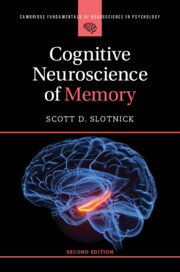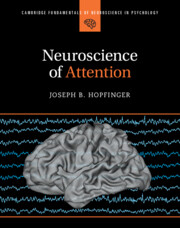Refine search
Actions for selected content:
26 results
Transcranial magnetic stimulation reveals divergent roles of left inferior frontal gyrus in bilingual language control and domain-general cognitive control
-
- Journal:
- Bilingualism: Language and Cognition , First View
- Published online by Cambridge University Press:
- 25 November 2025, pp. 1-14
-
- Article
-
- You have access
- Open access
- HTML
- Export citation

Cognitive Neuroscience of Memory
-
- Published online:
- 12 June 2025
- Print publication:
- 30 January 2025
-
- Textbook
- Export citation
3 - Investigating the Brain
-
- Book:
- Neuroscience of Attention
- Published online:
- 02 May 2025
- Print publication:
- 22 May 2025, pp 58-90
-
- Chapter
- Export citation

Neuroscience of Attention
-
- Published online:
- 02 May 2025
- Print publication:
- 22 May 2025
-
- Textbook
- Export citation
Chapter Two - The Tools of Cognitive Neuroscience
-
- Book:
- Cognitive Neuroscience of Memory
- Published online:
- 12 June 2025
- Print publication:
- 30 January 2025, pp 26-50
-
- Chapter
- Export citation
Case 12 - “I Am in Hell and I Will Die in Hell”
- from Section 2 - Mood Disorders
-
- Book:
- Clinical Case Studies in Long-Term Care Psychiatry
- Published online:
- 31 October 2024
- Print publication:
- 14 November 2024, pp 57-61
-
- Chapter
- Export citation
Chapter 4.1 - Bipolar Disorder
-
-
- Book:
- Seminars in General Adult Psychiatry
- Published online:
- 04 April 2024
- Print publication:
- 18 April 2024, pp 162-182
-
- Chapter
- Export citation
Chapter 3.3 - Drug and Physical Treatments of Depression
-
-
- Book:
- Seminars in General Adult Psychiatry
- Published online:
- 04 April 2024
- Print publication:
- 18 April 2024, pp 108-146
-
- Chapter
- Export citation
Efficacy and safety of transcranial magnetic stimulation on cognition in mild cognitive impairment, Alzheimer’s disease, Alzheimer’s disease-related dementias, and other cognitive disorders: a systematic review and meta-analysis
-
- Journal:
- International Psychogeriatrics / Volume 36 / Issue 10 / October 2024
- Published online by Cambridge University Press:
- 08 February 2024, pp. 880-928
-
- Article
- Export citation
High-frequency rTMS in the treatment of depressive symptoms in schizophrenia: a neurophysiological profile of respondents and nonresponders
-
- Journal:
- European Psychiatry / Volume 65 / Issue S1 / June 2022
- Published online by Cambridge University Press:
- 01 September 2022, p. S774
-
- Article
-
- You have access
- Open access
- Export citation
TMS use in Depressive disorder in Youth
-
- Journal:
- European Psychiatry / Volume 65 / Issue S1 / June 2022
- Published online by Cambridge University Press:
- 01 September 2022, p. S739
-
- Article
-
- You have access
- Open access
- Export citation
Efficacy and safety of intermittent theta burst stimulation (iTBS) in treatment resistant depression
-
- Journal:
- European Psychiatry / Volume 65 / Issue S1 / June 2022
- Published online by Cambridge University Press:
- 01 September 2022, p. S88
-
- Article
-
- You have access
- Open access
- Export citation
Tinnitus as a comorbidity to depression and transcranial magnetic stimulation as a treatment for both - case report
-
- Journal:
- European Psychiatry / Volume 65 / Issue S1 / June 2022
- Published online by Cambridge University Press:
- 01 September 2022, p. S741
-
- Article
-
- You have access
- Open access
- Export citation
Randomized comparative study of 1-Hz transcranial magnetic stimulation (TMS), continuous theta-burst stimulation (cTBS) and sham-TMS for treatment-refractory auditory hallucinations (AH) in schizophrenia
-
- Journal:
- European Psychiatry / Volume 65 / Issue S1 / June 2022
- Published online by Cambridge University Press:
- 01 September 2022, p. S737
-
- Article
-
- You have access
- Open access
- Export citation
Transcranial magnetic stimulation and post-traumatic stress disorder
-
- Journal:
- European Psychiatry / Volume 65 / Issue S1 / June 2022
- Published online by Cambridge University Press:
- 01 September 2022, p. S674
-
- Article
-
- You have access
- Open access
- Export citation
The frequency-dependent stimulation effects of rTMS on the performance of problem-solving tasks and ongoing oscillations
-
- Journal:
- European Psychiatry / Volume 65 / Issue S1 / June 2022
- Published online by Cambridge University Press:
- 01 September 2022, p. S257
-
- Article
-
- You have access
- Open access
- Export citation
Transcranial magnetic stimulation in the management of autism spectrum disorder: Narrative review
-
- Journal:
- European Psychiatry / Volume 64 / Issue S1 / April 2021
- Published online by Cambridge University Press:
- 13 August 2021, p. S491
-
- Article
-
- You have access
- Open access
- Export citation
Transcranial magnetic stimulation and eating disorders, any efficacy?
-
- Journal:
- European Psychiatry / Volume 64 / Issue S1 / April 2021
- Published online by Cambridge University Press:
- 13 August 2021, pp. S357-S358
-
- Article
-
- You have access
- Open access
- Export citation
An Implicit Plan Still Overrides an Explicit Strategy During Visuomotor Adaptation Following Repetitive Transcranial Magnetic Stimulation of the Cerebellum
-
- Journal:
- Experimental Results / Volume 1 / 2020
- Published online by Cambridge University Press:
- 30 June 2020, e16
-
- Article
-
- You have access
- Open access
- HTML
- Export citation
Efficacité de la stimulation magnétique transcrânienne (TMS) dans le traitement de la dépression en conditions naturalistiques : à partir d’une étude de cohorte
-
- Journal:
- European Psychiatry / Volume 28 / Issue S2 / November 2013
- Published online by Cambridge University Press:
- 16 April 2020, pp. 103-104
-
- Article
-
- You have access
- Export citation
